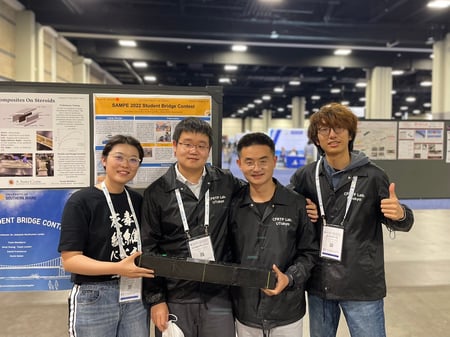Share this
On 25th May 2022, Qian Gao(D2), Xiaohang Tong(D1), Zihao Zhao(D1), Ruochen Xu(D1), Department of Systems Innovation, Takahashi-Wan Laboratory, received "2022 SAMPE Student Bridge Contest World Championship"
2022 SAMPE Student Bridge Contest World Championship
Society for the Advancement Material and Process Engineering (SAMPE) Student Bridge Contest World Championship is an annual competition for lightweight bridges made of fiber-reinforced composites, and is divided into eight categories based on the type of reinforcing fiber and bridge shape. The University of Tokyo team won the 2022 competition in Category B (hollow rectangular cross section bridge using carbon fiber).
About awarded research
The winning team of the Japan competition is sent to this world competition as the representative of Japan. Takahashi-Wan laboratory had won the Japan competition for the past three consecutive years, but it had been three years since the world competition was held due to Covid-19. After the optimal structural design by FEM utilizing the anisotropic properties of carbon fiber, we repeated the molding and evaluation tests by hand many times and entered the world competition with our best bridge, which was estimated to have the smallest strength variation based on appearance and sound diagnosis.
Your impression & future plan
We are very honored to receive this award. We would like to express our deepest gratitude to the members of our laboratory for making it possible for us to receive this award. We did the best we could do at the moment, but we feel fortunate to have won against world-class universities such as the University of Washington and UCLA, which are regular winners of this award. We gained valuable insights and advice from the interaction with these universities, and we will continue to improve our design and molding techniques to pass them on to the younger members in our laboratory.
These Related Stories
